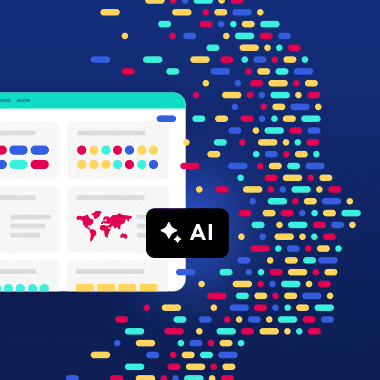How to set up a data marketplace in your organization

Setting up an internal data portal is crucial to centralize and democratize access to data securely. It is the foundation to drive transformation towards a true data-centric culture. Find out how to deploy one in this article.
According to our latest study, nine out of 10 decision-makers understand the importance of data in driving digital transformation. However, less than 40% believe that data democratization is actually in place within their organization. Illustrating this, in 63% of cases, employees have limited or no access to data.
These figures reveal a major contradiction. Businesses recognize the importance of data, but don’t have the structures in place to optimize its use. Our research reveals that only 8% of organizations use a data portal. Could issues around seamless sharing and access, which force employees to rely on emailing Excel files around the business, be the reason for such a gap between strategy and reality?
Setting up an internal data portal is crucial to centralize and democratize access to data securely. It is the foundation to drive transformation towards a true data-centric culture. Find out how to deploy one in this article.
The definition of an internal data portal
An internal data portal, sometimes referred to as a data marketplace, data catalog, data intranet, or private data space is a web-based platform. It centralizes and provides access to data assets from multiple sources in an organization through a unified repository. Accessible to all members of the organization, while allowing granular management of access rights to guarantee data security and confidentiality, internal data portals enable the discovery, access and use of data by all employees, regardless of their department, from marketing and sales to finance and operations.
It has four key aims:
- Enable simple and direct access to all relevant data in the organization in order to maximize its value.
- Encourage the reuse of data across the organization – not just by data scientists.
- Offer intuitive search and visualization tools for better data understanding and more informed decision-making.
- Ensure compliance with rigorous data security and governance processes more simply, while respecting organizational privacy policies and wider regulations.
The benefits of an internal data portal
Improved productivity
Deploying an internal data portal significantly improves productivity by centralizing access to information. This simplifies data discovery and reuse, reducing the time it takes to find and use relevant information. As data is trustworthy, reliable and available to all departments, teams can respond faster to requests and opportunities, increasing operational efficiency and minimizing response times.
Accelerated decision-making
An internal portal enriches the decision-making process by making data easily accessible and understandable through dynamic visualizations and dashboards. This accessibility allows decision-makers to better understand trends and performance in real-time, something which is crucial to respond rapidly to changing markets, while encouraging innovation within the organization.
Monitoring and tracking internal performance
A data portal allows you to track internal operations through key performance indicators and detailed reports. This helps managers better monitor progress, identify areas for improvement, and make strategic decisions based on reliable and up-to-date data.
Encourage innovation and the development of new services
By making data easier to access and reuse, an internal portal drives innovation within the organization. Employees can leverage existing data to develop new services, improve current products, and offer innovative solutions. This approach can also create new revenue streams. For example, Birdz by Veolia has transformed its Internet of Things (IoT) data into high value-added insights through its “Dashboards as a Service” offer.
The essential features of an internal data portal
A well-designed internal data portal provides a full range of features, both for end users and administrators, ensuring efficient and secure use of data. These capabilities include:
For users
Advanced navigation and search: Integrating artificial intelligence (AI) into portal search makes it possible to filter and find relevant data quickly. This helps users locate the information they need without wasting time sifting through long lists of search results.
- Multilingual: In a global environment, it is crucial that data is accessible in multiple languages. This feature ensures that all users can use the portal without language barriers, facilitating wider collaboration.
- Comprehensive catalog of assets: An internal portal should centralize all types of data assets, including datasets, visualizations, and APIs, in one place. This ensures that all data resources are available through a single point, simplifying data access and management.
- Ease of reuse and sharing: The portal should enable users to download data in multiple formats such as CSV, XLS, or JSON, and connect to datasets via APIs. This allows for easy reuse of data across different tools and applications, increasing its value and impact.
- Interactive visualizations: Transforming raw data into understandable graphs using interactive visualization tools facilitates better analysis and decision-making.
- Custom alerts and notifications: Custom alerts and notifications about updates or the addition of relevant new data keeps users informed and enables them to use information more effectively.
- Simplified connections to public data: The ability to cross-reference internal data with public data – such as through the Opendatasoft Data hub – allows users to discover new perspectives and create greater value.
For administrators
- Granular access management: It’s crucial to ensure that only authorized individuals can access sensitive data. Granular access management controls who can view, edit, or share data, ensuring information security and privacy.
- Integration with the existing tech infrastructure: To ensure smooth operations, the portal must integrate with the organization’s existing IT, such as ERP and CRM solutions, as well as other data management tools. This creates a unified workflow and reduces data silos.
- Data lineage: This feature, available within the Opendatasoft solution, provides detailed insights into how data is being used within the organization. It allows administrators to see how data is being consumed, spot usage trends, and identify opportunities for improvement.
- Metadata management: To make data easily discoverable and understandable, it’s essential to describe it with detailed metadata. This includes descriptions, keywords, and information about the source and quality of the data, making it easier to find and use.
- Automated data flows: Administrators can set up automated workflows for data acquisition, processing, and distribution, speeding up sharing by reducing manual tasks, and decreasing the risk of errors.
- Security and compliance: Administrators have to ensure that the portal adheres to all relevant security and compliance standards, such as the GDPR, by implementing access controls, regular audits, and robust security protocols.
Through these features, an internal data portal becomes a powerful and intuitive tool that not only facilitates access to data and encourages its use, but also improves productivity, decision-making, and innovation within the organization. Want to know more? Download our dedicated ebook.
The uses of an internal data portal
Case study: ICF Habitat
Real estate company ICF Habitat manages a portfolio of 95,000 homes across France. To deliver more strategic and responsive property management it has created an internal data portal to centralize all of its information, providing employees with advanced analytical tools and intuitive dashboards. Through its portal, ICF Habitat has significantly improved operational efficiency, reduced data management costs, and optimized the services provided to tenants. Centralized data allows for a clearer and more reliable overview of areas such as energy performance and maintenance needs, contributing to better-informed and more timely decision-making.
Case study: Caisse des Dépôts
Caisse des Dépôts, a French public sector financial institution focused on economic development, has created an internal portal accessible to its 6,000 employees, with the aim of improving the management and sharing of financial and economic information. The portal centralizes datasets covering areas as diverse as social housing, investment programs, funding for training, and retirement benefits. This enables employees to easily carry out even complex analyses while reducing the time required to prepare data. Since its launch, the portal has grown to include more than 2.2 million records and has seen 4.3 million API calls in 12 months, demonstrating its impact on operational efficiency.
Case study: Ministry of Economy and Finance
Launched in 2019, the portal of the French Ministry of Economy and Finance centralizes more than 430 datasets on topics such as budget data and foreign trade. The portal, developed with Opendatasoft, helps ensure data is easily available and provides a range of dashboards and visualizations that make it easy for a wide range of users to access and analyze data. Showing its success, it is now generating 15 million API calls per month from 20,000 regular users.
Deploy an Internal Data Portal with Opendatasoft
Implementing an internal data portal not only transforms data management, but it accelerates greater efficiency and innovation within your organization. Spreading a data culture within the organization, through employee awareness and training, is essential to maximize your portal’s benefits. Supporting business units by providing relevant, concrete use cases based on data, and demonstrating the tangible benefits of information sharing creates a more innovative, effective and efficient organization.
To remain relevant and useful, an internal data portal has to be regularly updated and improved. This includes adding new data, improving functionality, and integrating new technologies, such as AI. Features such as automated dataset updates ensure that information is always up-to-date and reliable.
Opendatasoft offers an intuitive and comprehensive data portal solution that meets the needs of both users and administrators, facilitating the transition to a data-driven culture. We support you at every stage of your digital transformation, ensuring your data is always up-to-date and reliable. Learn how we can help you get the most out of your data.

Successfully harnessing data is at the heart of corporate success, putting the focus on the Chief Data Officer (CDO) to build data-centric organizations. However, CDOs face a wide range of challenges to achieving success. Our blog explains how implementing one-stop-shop data portals helps CDOs demonstrate value, unlock fresh resources and build for the future.

Over the past months Opendatasoft has been working to transform its data portal solution by enriching it with AI, helping clients to save time, improve the experience for their users, and reduce the risk of errors within processes.

In a changing world, cities and municipalities need to provide seamless access to reliable, high-quality data to all employees if they are to meet their objectives around efficiency, improving the lives of residents, innovation and sustainability. We explain the importance of internal data portals to delivering on these needs.
